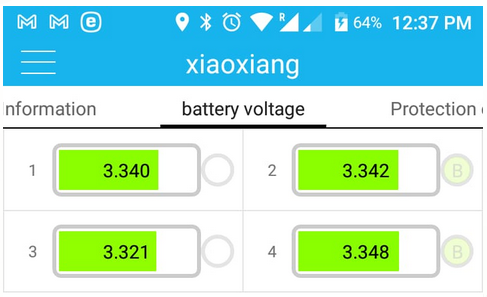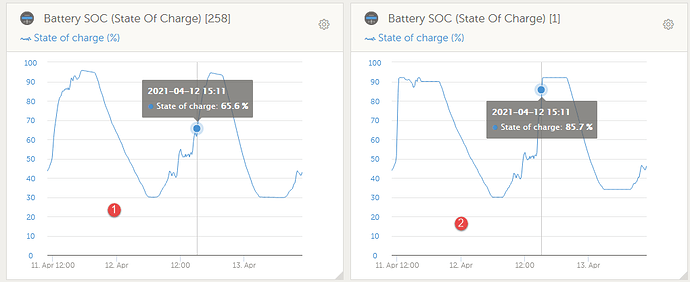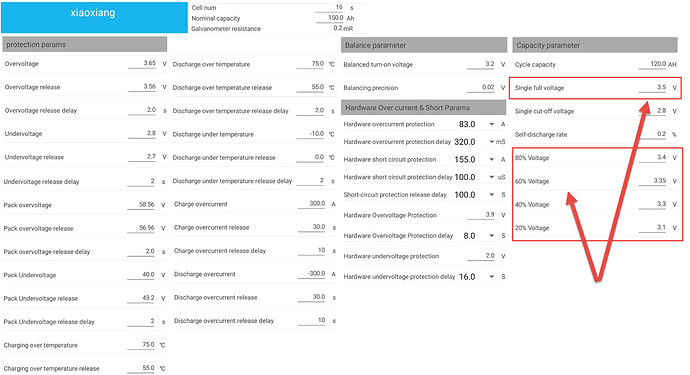I assume it depends on a bit more factors, like the temperature of the cells while at a high state of charge etc.
MY assumption would be that if the BMS was able to charge the battery up to 100Ah before, but now it can only go to 90Ah before it trip alarms(cell imbalance, etc) then that would be a 10% reduction.
So the SOH would be 90%
(simplified, but the general idea should be close to this)
PS. The LTT/JDB has a function to be able to adjust the battery size up/down using something similar to the above. If you keep track of this drift then then will be the SOH
But it has no idea it is at 100Ah. It might be counting amps over hundreds of cycles, but there would be drift over time. You never really know a battery is flat until it is at 0V relative to ground?
My personal experience is this, I installed my PylonTech bank in 2016 and they now have over 600 cycles each. All 5 batteries are showing a SOH of 100%.
I discharge them daily to a DOD of 30%.
I think the best way to ensure good battery health is not to hammer the packs during charge and discharge and to keep them as cool as possible. Heat build up is definitely the killer.
There are many factors that can be used to calculate the health of a battery. Internal resistance, voltages, number of cycles it has done, age, etc.
But in the end if you can measure the charge it can take and then give, this should be the biggest measure.
I think it would have a very good idea. That proximation (it won’t be perfect) will give a good indication. The BMS can measure the the current it supply and the current it gives. Even if there is a bit of drift that would be a small percentage and you only need one full charge cycle to reset that drift.
But how will it know that a full charge cycle was completed? Discharged to 20%? But how does it know that it reached 20%?
And THERE is the REAL question!!! 
1 - BMV SOC
2 - BMS SOC
Now the BMS I have has a shunt “they” say. BUT the BMS SOC is volts-based. So there IS that.
BUT, all in, I’m quite satisfied so far. close as damn to the BMV, this Jaibaba BMS I so like, that we want to order more of, even though we are “stuck” with the parts shortage in China.
FWIW, we can get the previous model BUT they cannot add the RS485 port due to sai shortage, a part that I so highly recommend one gets to be able to use Bluetooth AND connect BMS at the same time to the Venus. Becomes a HUGE bonus if you want to balance a bank!
But if the BMS has no shunt, as the 12v BMS does not one, I have NO idea how accurate it is.
Will one day put the BMV on the 12v BMS and do a comparison … but not today.
Actually, the SOC is not based on the voltage in this BMS, but rather on the current usage. These voltages highlighted are per cell. You can get a cell SOC indication from them, but they do not influence the battery SOC.
If your cells each has a capacity of 100Ah, but in your BMS you set the battery capacity to 200Ah, the BMS will say you are at 50% SOC even though all your cells have their 100Ah charge (thus 100% SOC for the cell and all above 3.45V). When your BMS trips from a overvoltage cell imbalance it will start looking at the cell SOC voltages you specified and adjust your overall battery capacity down until the overvoltage does not happen (this over many cycles).
Now you stated that the battery capacity was 200Ah. The BMS has downgraded this to 100Ah over time to match your cells and your SOH will be 50% your original value.
It’s the same idea here. With the battery on 20% SOC, the BMS can compare the cell voltages to what they were a month ago at 20%. Any deviation will indicate an issue.
Coulomb-counting. Well, perhaps not down to that level, but it comes down to that. It can measure the current coming in and out, and it’s child’s play for a small CPU to do a bit of numeric integration to work out the amp-hours that are coming in and out.
So the BMS knows how many amp hours comes in and how many goes out.
It also knows the battery is full based on the cell voltages. There will be some sort of algorithm here, but for a well balanced battery, pretty much at 3.55V, the battery is full. At this point it “syncs” the SOC to 100%, and counts backwards from this as you discharge.
If a low cell is detected on discharge, the battery detects the other “stop end”. That’s the 0% mark. I’ve seen batteries that sat on 0% SOC for a long time before a cell finally dropped out… which is an indication that the BMS underestimated the total capacity.
In theory then, by watching voltages and looking for the stop-ends, the BMS can track the overall capacity of the battery, and from that it can estimate what 20% would be (relative to the last determined capacity). It can also calculate a SOH from that. If you are expecting 100Ah, and you only get 95Ah, you know you lost 5%.
So I would expect that if you cycle your batteries really shallowly, the SOH number may remain stuck at 100 for quite a while. It’s an estimate, based on the last time it got the data required to do the calculation.
I’ve seen a jump from 85% to 100% SOC instantly based on one cell that “ran away” to over 3.65v.
Now I agree, that is the exception.
And I agree there is some trickery to get the SOC as accurate as possible.
Me, I’m sticking to a BMV for a proper SOC, that <R2.5k is nothing over the years a BMV lasts.
Exactly. That cell is unbalanced. If it keeps on hitting that imbalance cell at 85% SOC the BMS will downgrade your battery capacity over time so that it will reach the 100% SOC when the cells are full.
In this case the BMS is the correct one and not the BMV.
Here, hold my beer … just balance the cells, top and bottom, and the problem goes away.
That is where it comes in SO nicely that your software does its part via the Venus via the RS485 port, with one watching the cells individually via Bluetooth on ones phone, that one can stop that cell with “The Bulb V2”. 
Once the cells behave … give me back my beer. 
Now as to what happens if you have an imbalance.
The battery will have some sort of algorithm to come up with a “eeeh good enough” number. And it will be something like
- if all cells are above 3.45V and one is above 3.55V, the battery is full.
- If one cell is above 3.55V but not all other cells are above 3.45V, the battery is 95% full.
- If any cell is below 2.8V, the battery is empty (0% SOC).
- Otherwise the battery is at whatever number is in the accumulator (from which is constantly added and subtracted according to current coming in and going out).
Battery makers also don’t like to get too many support questions from customers. So some may even decide to just show 100% if any cell is high… otherwise people call and ask annoying questions like why it stops on 95%. True story.
Once the battery balances, which happens within the first month of its life, the algorithm works pretty well.
This new DVCC feature on the Venus to lower the Charge Voltage, what a life saver!!!
Like here, swapped two cells out, dropped the Charge Voltage to get the cells to balance slower … as all were not on the same voltage when I started.
Between @Louisvdw software on the Venus, Bluetooth, and the new DVCC feature, balancing a new bank, or 2nd Life bank rather, has now become a breeze.
Cells 1 and 2 “new”, and was on a higher voltage than 3 and 4 as I swapped them out. Soon as these 4 cells are “settled”, I can “forget” about them.

Now I just need a new 24v BMS to have all these side projects powering the house at night or sell it all, balanced, when the 280ah cells do arrive one day. 
Say thanks to Guy Stewart who pushed hard on that… ![]()

